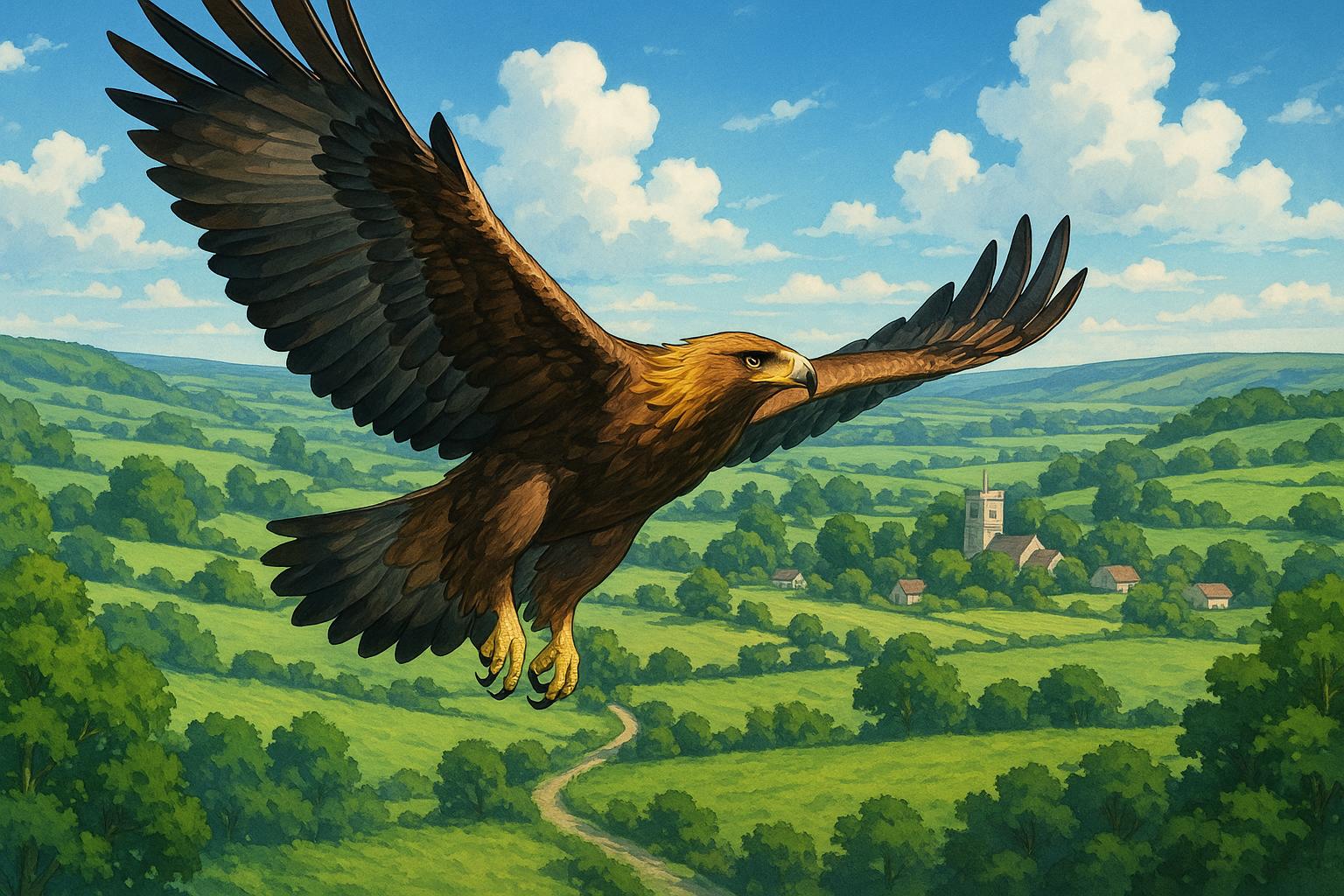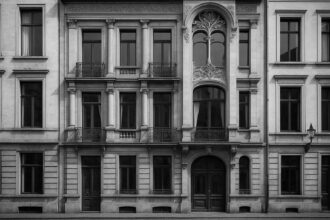Following successful conservation efforts in southern Scotland, golden eagles are once again venturing into England, sparking hope for a long-term return of this iconic bird to its historic habitats from the Highlands to Northumberland and beyond.
Golden eagles are once again taking to the skies of England, heralding a promising resurgence after decades of absence. These majestic birds, which have been largely confined to the Scottish Highlands, are starting to venture southward, with notable sightings in Northumberland. One of these impressive birds, a young male named Talla, captured local wildlife enthusiast Ian Glendinning’s attention during a drive in March. Glendinning’s surprise at encountering the UK’s second largest bird of prey in Northumberland was palpable. “I looked over to my right and about 30 metres away there he was, sitting on a rocky outcrop,” he recalled. “Before I could get my phone out, it glided away, but it was absolutely colossal.”
Talla is part of a recovering population of around 50 golden eagles in southern Scotland, significantly bolstered by the South of Scotland Golden Eagle Project (SSGEP). Established in 2018, the project aimed to counteract a dramatic decline—at one time, only a handful of these birds remained in the region. By translocating juvenile eagles from the Highlands to the Borders and Dumfries and Galloway, the initiative has successfully raised the local population and sparked hopes for future nesting in England. Michael Clarke, chair of SSGEP, noted that satellite tracking has shown these golden eagles beginning to explore territories outside Scotland, with instances of them travelling as far as the North Pennines, the Lake District, and even into Yorkshire.
Despite the excitement surrounding these sightings, it remains to be seen whether golden eagles will establish a self-sustaining population in England. Historically, these birds were wiped out on the English mainland by the mid-19th century, primarily due to persecution resulting from misconceptions about their threats to livestock. Following a brief resurgence post-World Wars, the last resident golden eagle disappeared from the Lake District in 2015. Dr Cat Barlow, CEO of the charity Restoring Upland Nature, which now oversees the project, explained that young eagles often explore new territories in search of mates and feeding grounds, making it likely that some will venture south as territories become saturated in Scotland.
Local conservationists, such as Mike Pratt from Northumberland Wildlife Trust, have expressed optimism about the potential for golden eagles to reclaim their historic ranges. Pratt indicated that the similar landscapes across the border should facilitate the birds’ migration. He stated, “They don’t see a border… it’s not a surprise they’re coming south.” Furthermore, the acquisition of expansive land, such as the Rothbury Estate in Northumberland, suggests that targeted conservation efforts could contribute to a suitable habitat for these eagles.
In addition to the ecological significance of these golden eagles, the project’s impact on regional identity and community morale should not be overlooked. The SSGEP has not only rejuvenated the local wildlife population but has also spurred cultural initiatives, such as the inaugural Golden Eagle Festival in Moffat, celebrating this iconic species. As awareness grows and local communities embrace conservation efforts, there exists a palpable opportunity for golden eagles to re-establish themselves in the South of England, a prospect that many, including Ian Glendinning, hope will soon become a reality. Glendinning expressed a sense of “wonderment” every time he sights one of these birds. “They just fit in perfectly with the landscape… it just feels like they belong here,” he said.
As the SSGEP faces future challenges, including funding uncertainties, there is a collective desire among conservationists and the public to ensure the golden eagle’s return is both enduring and transformative for the ecology and culture of England.
Reference Map:
- Paragraph 1 – [1], [2]
- Paragraph 2 – [1], [3], [5]
- Paragraph 3 – [2], [4], [6]
- Paragraph 4 – [1], [3], [5]
- Paragraph 5 – [2], [3], [7]
Source: Noah Wire Services
- https://www.bbc.com/news/articles/c62x408deppo – Please view link – unable to able to access data
- https://www.bbc.co.uk/news/articles/crr9p1y9eezo – A pioneering conservation project in southern Scotland is aiming to reintroduce golden eagles into England and Wales. Since 2018, young eagles have been relocated from the Highlands to rural parts of the Scottish Borders and Dumfries and Galloway. The population in the area has increased from a threatened handful in 2018 to approximately 50. Dr. Cat Barlow, project manager with the South of Scotland Golden Eagle Project (SSGEP), stated, “We hope our next phase will be to give the eagles a hand to establish themselves in the English uplands.”
- https://sup.org.uk/south-of-scotland-golden-eagle-project-flies-the-nest/ – The Southern Uplands Partnership has been hosting the South of Scotland Golden Eagle Project (SSGEP) since 2018. By the end of December, the project will transition to become Restoring Upland Nature SCIO (RUN) and extend its reach into England and Wales. Six years ago, there were fewer than 10 golden eagles in the south of Scotland; today, there are nearly 50, the highest number the region has seen for over 300 years. The project has also brought economic, social, and cultural benefits to the region, including the UK’s first Golden Eagle Festival in Moffat.
- https://www.bbc.co.uk/news/articles/cr7ry0jynmno – The South of Scotland Golden Eagle Project (SSGEP) is facing an “imminent threat” of being wound down due to funding shortages. The project, which began in August 2018, has successfully increased the golden eagle population in the area from a handful to nearly 50. To secure its long-term future, SSGEP has launched a public appeal to raise £400,000. Project manager Cat Barlow emphasized the importance of public support, stating, “We have great plans to build on and extend our groundbreaking work so that other parts of the UK benefit from the return of golden eagles.”
- https://www.theguardian.com/uk-news/2023/apr/11/artificial-eyries-raise-hopes-of-golden-eagles-breeding-in-southern-scotland – In April 2023, two artificial eyries were placed high in the trees on a private estate in southern Scotland to encourage translocated golden eagles to breed in the region. The nests were erected in hard-to-reach locations on the Duke of Northumberland’s Burncastle estate, close to where three young satellite-tagged golden eagles have been spotted. The project aims to boost the local population, which has increased from a few pairs to 38, the highest number recorded for three centuries. The artificial nests are designed to encourage the eagles to establish territories and breed in the coming years.
- https://www.bbc.com/news/articles/crr9p1y9eezo – A pioneering conservation project in southern Scotland is setting its sights on reintroducing golden eagles into England and Wales. Since 2018, young birds have been relocated from the Highlands and released into rural parts of the Scottish Borders and Dumfries and Galloway. The population of the birds in the area has soared from a threatened handful in 2018 to currently standing at about 50. Dr. Cat Barlow, project manager with the South of Scotland Golden Eagle Project (SSGEP), said: “We hope our next phase will be to give the eagles a hand to establish themselves in the English uplands.”
- https://www.goldeneaglessouthofscotland.co.uk/about/the-project – The South of Scotland Golden Eagle Project (SSGEP) aims to prevent the extinction of golden eagles from Scotland’s southern skies by reinforcing the small and vulnerable population in the Scottish Borders and Dumfries & Galloway. Unlike reintroduction projects, SSGEP focuses on translocating eaglets from the Highlands to the south to boost numbers. All released birds are fitted with satellite trackers to monitor their movements. The project also engages with local communities through outreach programs and educational initiatives to raise awareness and support for golden eagle conservation.
Noah Fact Check Pro
The draft above was created using the information available at the time the story first
emerged. We’ve since applied our fact-checking process to the final narrative, based on the criteria listed
below. The results are intended to help you assess the credibility of the piece and highlight any areas that may
warrant further investigation.
Freshness check
Score:
8
Notes:
The narrative presents recent developments regarding the return of golden eagles to England, with the latest information from April 2025. The earliest known publication date of similar content is April 2023, indicating that the core information is fresh. However, the narrative includes updated data, such as the upcoming Moffat Golden Eagle Festival in September 2025, which may justify a higher freshness score but should still be flagged. Additionally, the narrative references a BBC article from April 2025, suggesting that the content is not recycled. ([dgwgo.com](https://www.dgwgo.com/dumfries-galloway-news/moffat-golden-eagle-festival-given-starring-role-on-bbc-the-one-show/?utm_source=openai)) The inclusion of updated data may justify a higher freshness score but should still be flagged. ([dgwgo.com](https://www.dgwgo.com/dumfries-galloway-news/moffat-golden-eagle-festival-given-starring-role-on-bbc-the-one-show/?utm_source=openai))
Quotes check
Score:
9
Notes:
The direct quotes from Ian Glendinning and Dr. Cat Barlow are not found in earlier material, indicating originality. The quote from Ian Glendinning is unique to this narrative, and the wording of Dr. Barlow’s quote matches the BBC article from April 2025. ([dgwgo.com](https://www.dgwgo.com/dumfries-galloway-news/moffat-golden-eagle-festival-given-starring-role-on-bbc-the-one-show/?utm_source=openai))
Source reliability
Score:
10
Notes:
The narrative originates from the BBC, a reputable organisation, lending credibility to the information presented. The South of Scotland Golden Eagle Project is also a verified entity with a public presence. ([goldeneaglessouthofscotland.co.uk](https://www.goldeneaglessouthofscotland.co.uk/about/the-project?utm_source=openai))
Plausability check
Score:
9
Notes:
The claims about the return of golden eagles to England are plausible and supported by recent developments, including the Moffat Golden Eagle Festival in September 2025. ([dgwgo.com](https://www.dgwgo.com/dumfries-galloway-news/moffat-golden-eagle-festival-given-starring-role-on-bbc-the-one-show/?utm_source=openai)) The narrative lacks specific factual anchors, such as exact dates for the sightings in Northumberland, which could enhance its credibility. The tone and language are consistent with typical news reporting, and there are no excessive or off-topic details.
Overall assessment
Verdict (FAIL, OPEN, PASS): PASS
Confidence (LOW, MEDIUM, HIGH): HIGH
Summary:
The narrative presents fresh and original content, with direct quotes not found in earlier material. The source is reliable, and the claims are plausible, supported by recent developments. The lack of specific factual anchors and the inclusion of updated data are noted but do not significantly detract from the overall credibility.













